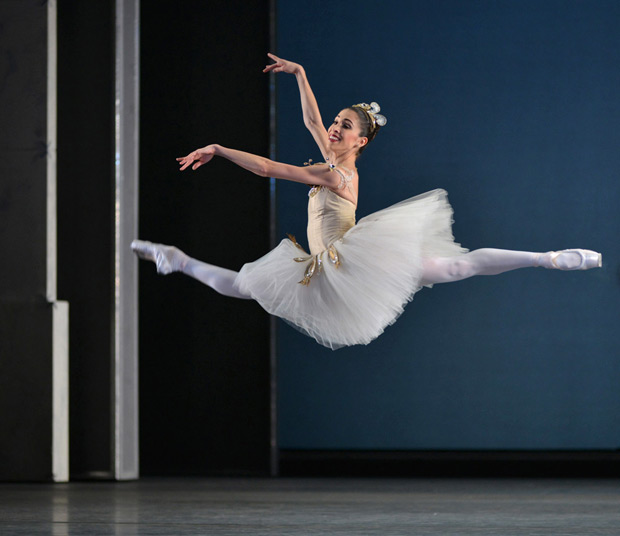
© Dave Morgan, courtesy the Royal Opera House. (Click image for larger version)
Royal Ballet
Jewels – Emeralds, Rubies, Diamonds
★★★★✰
London, Royal Opera House
1 April 2017
Gallery of pictures by Dave Morgan
www.roh.org.uk
The back of the cast sheet for the Royal Ballet’s revival of George Balanchine’s Jewels carries an advertisement for a Van Cleef & Arpels antique necklace of rubies and diamonds. The Fifth Avenue store didn’t sponsor the original New York production in 1967; it gained plenty of free publicity by association.
Although Balanchine said his three-act ballet had nothing to do with jewels ‘the dancers are just dressed like jewels’ – his choreographic arrangements refer to suites of jewellery: matching sets of necklaces, bracelets, earrings, which could be reassembled in varying combinations. The corps in each section link together in chains, cluster into brooches, form semi-circles like diadems. Their lustre is as distinctive as that of the gems in the titles: emeralds, rubies, diamonds.
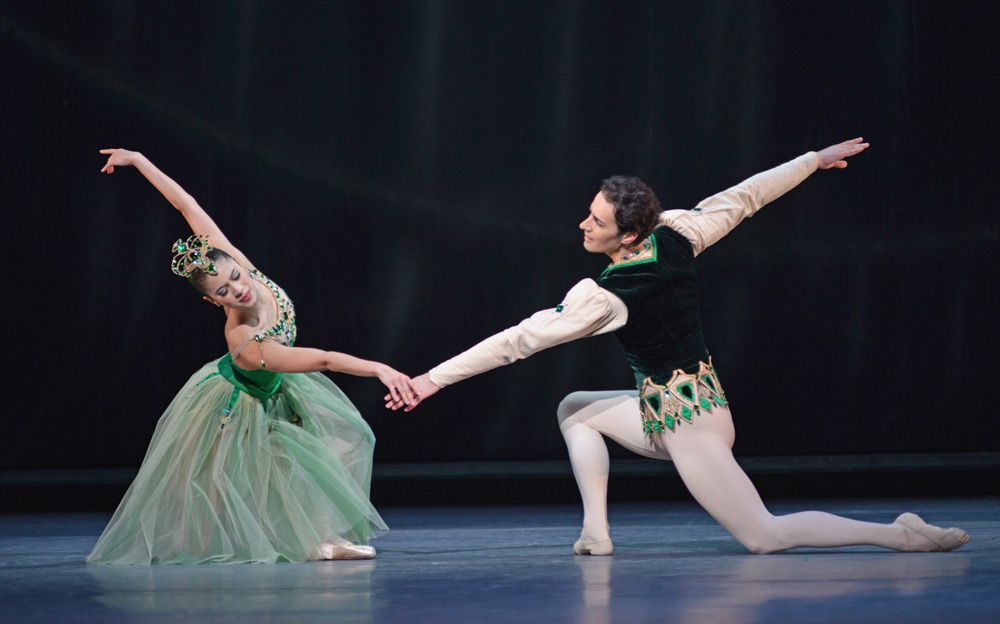
© Dave Morgan, courtesy the Royal Opera House. (Click image for larger version)
In Emeralds, to dreamy incidental music by Fauré, the dancers inhabit a shady green world. The corps of ten women twist and curl at the start like aquatic plants tugged by a current. The first ballerina, Beatriz Stix-Brunell, could be a water nymph, touching the hands of her suitor, Valeri Hristov, in the opening pas de deux before drifting out of reach. Then, in her solo, Stix-Brunell becomes a wilful ondine, playing with droplets of water and shafts of light. The second ballerina, Laura Morera, floats, rapt, on surges of music, her body swaying with every eddy.

© Dave Morgan, courtesy the Royal Opera House. (Click image for larger version)
Both dancers display facets of their beauty as if to prove they have no need of a partner. When the time comes for a pas de deux for each of them, the handholds are surprisingly intimate. Morera frees herself only briefly from Ryoichi Hirano’s encircling embraces as they promenade together. Stix-Brunell relies on Hristov to support as her upraised leg tick-tocks to Fauré’s time-clock.

© Dave Morgan, courtesy the Royal Opera House. (Click image for larger version)
A sprightly trio, James Hay with Anna Rose O’Sullivan and Helen Crawford, flits airily across a forest glade. Hay lands his leaps silently and impeccably as he takes command of his twin companions. When everyone returns for a deceptively upbeat (false) ending, he seems the odd man out. But Balanchine added a coda in 1976, in which the women depart one by one, leaving all three men bereft – with Hay at the forefront. The music mourns the death of Mélisande in Maeterlinck’s play Pelléas et Mélisande, making a melancholy end to the first of the three ballets.

© Dave Morgan, courtesy the Royal Opera House. (Click image for larger version)
Rubies is next as an antidote, set to Stravinsky’s jazzy Capriccio. Once again, there are two ballerinas: the good-time showgirl (Melissa Hamilton) who needs four men to pin her down, and the high-spirited one (Sarah Lamb) in league with the brash boy from the other side of the tracks (Steven McRae). Lamb and McRae are a class act, as fine-tuned as a clockwork mechanism. Her leg swings high from one side of her body to the other like a metronome as he holds her steady, then catches her way off-balance. No gentle tick-tock here, no serene promenades but sexy, speedy trots and whirlwind spins. Their co-ordination as a couple is so superb that their risk-taking goes almost unnoticed.

© Dave Morgan, courtesy the Royal Opera House. (Click image for larger version)
Hamilton, back with the Royal Ballet while still on leave to perform with the Dresden Semperoper Ballett, exudes an air of danger. Her control is precarious, a ruby pendant on too loose a chain. The fleet corps of men are more impressive than the prancing chorus girls, jutting their hips and flexing their wrists.

© Dave Morgan, courtesy the Royal Opera House. (Click image for larger version)
In Diamonds, the skeins of women in glittering white tutus resemble swans or snowflakes as they form symmetrical patterns to Tchaikovsky’s Third Symphony (minus the first movement). There’s a lot of repetition to an interminable waltz before the elegiac pas de deux begins for the central couple, Marianela Nunez and Thiago Soares. She is the idealised woman, the flawless diamond he can never hope to possess entirely. The partnering is intricate, almost always with her back to him until she surrenders in a deep fall into his arms. Nunez is serenely at ease with all the technical demands, unlike Soares: reliable as a partner, he is out of his league once he is on his own.
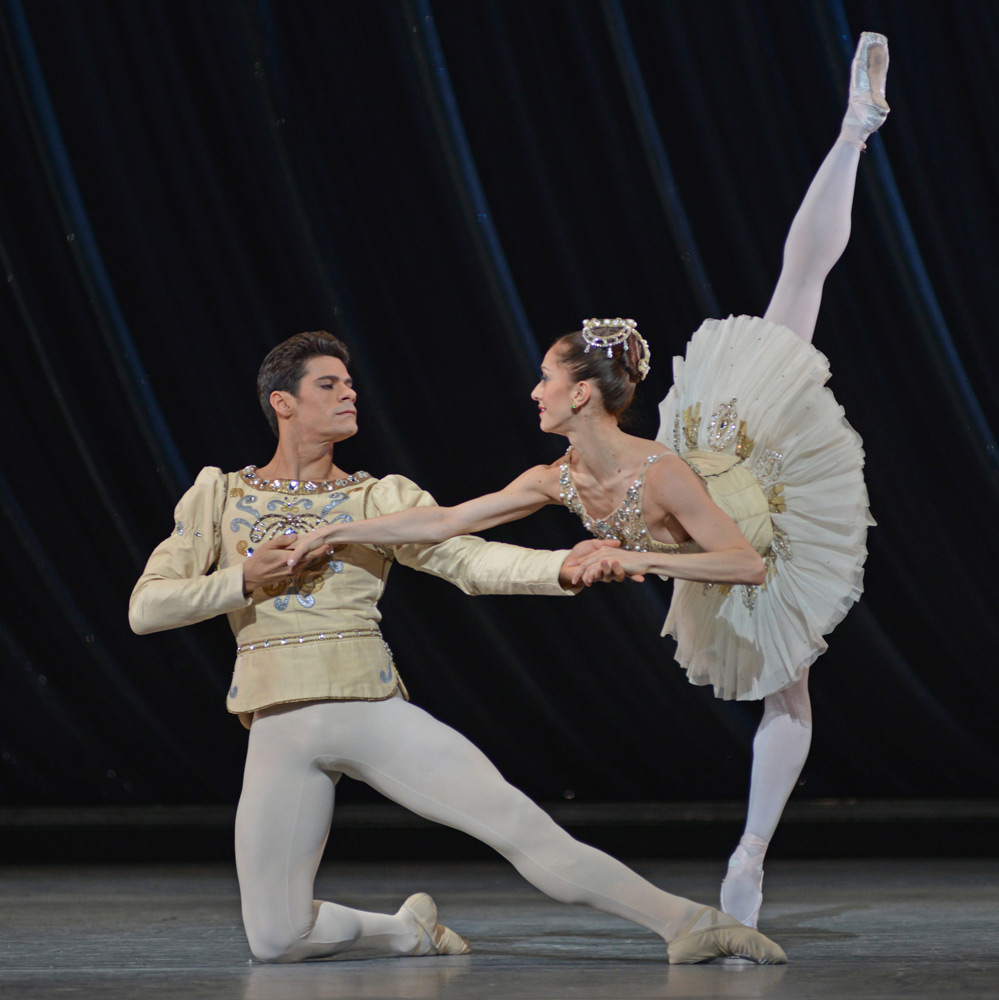
© Dave Morgan, courtesy the Royal Opera House. (Click image for larger version)
The long pas de deux is a distillation of a man’s adoration of a ballerina who is both remote and tantalisingly tender. The grand polonaise in the finale is a celebration of their union and a recapitulation of classical ballet’s mass effects. Though it’s not as dazzling as the polonaise in Balanchine’s earlier Theme and Variations, Diamonds guarantees a glamorous close to the evening. Fifty years on, the gems have lost none of their lustre. Their settings, though, in tired designs by Jean-Marc Puissant, could do with a re-think and a glossier polish.












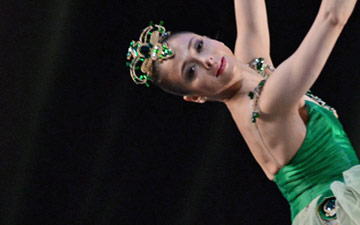
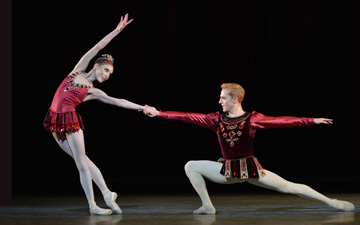


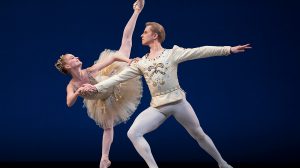
You must be logged in to post a comment.